DeWalt DW248 Handleiding
DeWalt
Boormachine
DW248
Bekijk gratis de handleiding van DeWalt DW248 (6 pagina’s), behorend tot de categorie Boormachine. Deze gids werd als nuttig beoordeeld door 42 mensen en kreeg gemiddeld 4.7 sterren uit 21.5 reviews. Heb je een vraag over DeWalt DW248 of wil je andere gebruikers van dit product iets vragen? Stel een vraag
Pagina 1/6

INSTRUCTION MANUAL
GUIDE D’UTILISATION
MANUAL DE INSTRUCCIONES
INSTRUCTIVO DE OPERACIÓN, CENTROS DE SERVICIO Y PÓLIZA
DE GARANTÍA. ADVERTENCIA: LÉASE ESTE INSTRUCTIVO ANTES
DE USAR EL PRODUCTO.
D WALT Industrial Tool Co., 701 East Joppa Road, EBaltimore, MD 21286 (OCT07)
Part No. 657054-00 DW217–DW249 Copyright © 2002, 2004, 2005, 2007 DEWALT
The following are trademarks for one or more DEWALT power tools: the yellow and black color scheme;
the “D” shaped air intake grill; the array of pyramids on the handgrip; the kit box configuration; and the
array of lozenge-shaped humps on the surface of the tool.
DW217, DW221, DW222, DW223, DW223G, DW223-220, DW226, DW231, DW235G
DW235-220, DW236, DW237, DW238, DW239, DW245, DW246, DW248, DW249
Drills
Perceuses
Taladros
Definitions: Safety Guidelines
The definitions below describe the level of severity for each signal word. Please read the
manual and pay attention to these symbols.
DANGER: Indicates an imminently hazardous situation which, if not avoided, result will
in death or serious injury.
WARNING: Indicates a potentially hazardous situation which, if not avoided, could
result in death or serious injury.
CAUTION: Indicates a potentially hazardous situation which, if not avoided, may result
in minor or moderate injury.
CAUTION: Used without the safety alert symbol indicates a potentially hazardous situation
which, if not avoided, result in may property damage.
IF YOU HAVE ANY QUESTIONS OR COMMENTS ABOUT THIS OR ANY DEWALT TOOL,
CALL US TOLL FREE AT: 1-800-4-DEWALT (1-800-433-9258)
WARNING: To reduce the risk of injury, read the instruction manual.
General Power Tool Safety Warnings
WARNING! Read all safety warnings and instructions Failure to follow the warnings
and instructions may result in electric shock, fire and/or serious injury.
SAVE ALL WARNINGS AND INSTRUCTIONS
FOR FUTURE REFERENCE
The term “power tool” in the warnings refers to your mains-operated (corded) power tool or
battery-operated (cordless) power tool.
1) WORK AREA SAFETY
a) Keep work area clean and well lit. Cluttered or dark areas invite accidents.
b) Do not operate power tools in explosive atmospheres, such as in the presence of
flammable liquids, gases or dust. Power tools create sparks which may ignite the dust
or fumes.
c) Keep children and bystanders away while operating a power tool. Distractions can
cause you to lose control.
2) ELECTRICAL SAFETY
a) Power tool plugs must match the outlet. Never modify the plug in any way. Do not
use any adapter plugs with earthed (grounded) power tools. Unmodified plugs and
matching outlets will reduce risk of electric shock.
b) Avoid body contact with earthed or grounded surfaces such as pipes, radiators,
ranges and refrigerators. There is an increased risk of electric shock if your body is
earthed or grounded.
c) Do not expose power tools to rain or wet conditions. Water entering a power tool will
increase the risk of electric shock.
d) Do not abuse the cord. Never use the cord for carrying, pulling or unplugging the
power tool. Keep cord away from heat, oil, sharp edges or moving parts. Damaged
or entangled cords increase the risk of electric shock.
e) When operating a power tool outdoors, use an extension cord suitable for outdoor
use. Use of a cord suitable for outdoor use reduces the risk of electric shock.
f) If operating a power tool in a damp location is unavoidable, use a residual current
device (RCD) protected supply. Use of an RCD reduces the risk of electric shock.
3) PERSONAL SAFETY
a) Stay alert, watch what you are doing and use common sense when operating a
power tool. Do not use a power tool while you are tired or under the influence of
drugs, alcohol or medication. A moment of inattention while operating power tools may
result in serious personal injury.
b) Use personal protective equipment. Always wear eye protection. Protective equip-
ment such as dust mask, non-skid safety shoes, hard hat, or hearing protection used for
appropriate conditions will reduce personal injuries.
c) Prevent unintentional starting. Ensure the switch is in the off position before
connecting to power source and/or battery pack, picking up or carrying the tool.
Carrying power tools with your finger on the switch or energising power tools that have the
switch on invites accidents.
d) Remove any adjusting key or wrench before turning the power tool on. A wrench or
a key left attached to a rotating part of the power tool may result in personal injury.
e) Do not overreach. Keep proper footing and balance at all times. This enables better
control of the power tool in unexpected situations.
f) Dress properly. Do not wear loose clothing or jewellery. Keep your hair, clothing and
gloves away from moving parts. Loose clothes, jewellery or long hair can be caught in
moving parts.
g) If devices are provided for the connection of dust extraction and collection facilities,
ensure these are connected and properly used. Use of dust collection can reduce dust-
related hazards.
4) POWER TOOL USE AND CARE
a) Do not force the power tool. Use the correct power tool for your application. The
correct power tool will do the job better and safer at the rate for which it was designed.
b) Do not use the power tool if the switch does not turn it on and off. Any power tool that
cannot be controlled with the switch is dangerous and must be repaired.
c) Disconnect the plug from the power source and/or the battery pack from the power
tool before making any adjustments, changing accessories, or storing power tools.
Such preventive safety measures reduce the risk of starting the power tool accidentally.
d) Store idle power tools out of the reach of children and do not allow persons unfa-
miliar with the power tool or these instructions to operate the power tool. Power tools
are dangerous in the hands of untrained users.
e) Maintain power tools. Check for misalignment or binding of moving parts, breakage
of parts and any other condition that may affect the power tool’s operation. If dam-
aged, have the power tool repaired before use. Many accidents are caused by poorly
maintained power tools.
f) Keep cutting tools sharp and clean. Properly maintained cutting tools with sharp cutting
edges are less likely to bind and are easier to control.
g) Use the power tool, accessories and tool bits etc., in accordance with these instruc-
tions taking into account the working conditions and the work to be performed. Use
of the power tool for operations different from those intended could result in a hazardous
situation.
5) SERVICE
a) Have your power tool serviced by a qualified repair person using only identical
replacement parts. This will ensure that the safety of the power tool is maintained.
Additional Safety Rules
• Wear ear protectors with impact drills. Exposure to noise can cause hearing loss.
• Use auxiliary handles supplied with the tool. Loss of control can cause personal injury.
• Hold tool by insulated gripping surfaces when performing an operation where the cut-
ting tools may contact hidden wiring or its own cord. Contact with a “live” wire will make
exposed metal parts of the tool “live” and shock the operator.
• Use clamps or other practical way to secure and support the workpiece to a stable
platform. Holding the work by hand or against your body is unstable and may lead to loss of
control.
• Keep handles dry, clean, free from oil and grease. It is recommended to use rubber
gloves. This will enable better control.
• An extension cord must have adequate wire size (AWG or American Wire Gauge) for
safety. The smaller the gauge number of the wire, the greater the capacity of the cable, that
is 16 gauge has more capacity than 18 gauge. An undersized cord will cause a drop in line
voltage resulting in loss of power and overheating. When using more than one extension to
make up the total length, be sure each individual extension contains at least the minimum
wire size. The following table shows the correct size to use depending on cord length and
nameplate ampere rating. If in doubt, use the next heavier gauge. The smaller the gauge
number, the heavier the cord.
Minimum Gauge for Cord Sets
Ampere Rating
Volts Total Length of Cord in Feet (meters)
120V 25 (7.6) 50 (15.2) 100 (30.5) 150 (45.7)
240V 50 (15.2) 100 (30.5) 200 (61.0) 300 (91.4)
More
Than
Not More
Than
AWG
0 6 18 16 16 14
6 10 18 16 14 12
10 12 16 16 14 12
12 16 14 12 Not Recommended
WARNING: Always wear proper personal hearing protection that conforms to ANSI
S12.6 (S3.19) during use. Under some conditions and duration of use, noise from this product
may contribute to hearing loss.
WARNING: ALWAYS use safety glasses. Everyday eyeglasses are NOT safety glasses.
Also use face or dust mask if cutting operation is dusty. ALWAYS WEAR CERTIFIED SAFETY
EQUIPMENT:
• ANSI Z87.1 eye protection (CAN/CSA Z94.3),
• ANSI S12.6 (S3.19) hearing protection,
• NIOSH/OSHA/MSHA respiratory protection.
WARNING: Some dust created by power sanding, sawing, grinding, drilling, and other con-
struction activities contains chemicals known to cause cancer, birth defects or other reproductive
harm. Some examples of these chemicals are:
• lead from lead-based paints,
• crystalline silica from bricks and cement and other masonry products, and
• arsenic and chromium from chemically-treated lumber (CCA).
Your risk from these exposures varies, depending on how often you do this type of work.
To reduce your exposure to these chemicals: work in a well ventilated area, and work with
approved safety equipment, such as those dust masks that are specially designed to filter out
microscopic particles.
• Avoid prolonged contact with dust from power sanding, sawing, grinding, drilling, and
other construction activities. Wear protective clothing and wash exposed areas with
soap and water. Allowing dust to get into your mouth, eyes, or lay on the skin may promote
absorption of harmful chemicals.
WARNING: Use of this tool can generate and/or disburse dust, which may cause serious and
permanent respiratory or other injury. Always use NIOSH/OSHA approved respiratory protection
appropriate for the dust exposure. Direct particles away from face and body.
• The label on your tool may include the following symbols. The symbols and their definitions
are as follows:
V ..................volts A ......................amperes
Hz ................ hertz W .....................watts
min ..............minutes ................... alternating current
............direct current no ....................no load speed
................Class I Construction ....................earthing terminal
.................... (grounded) ....................safety alert symbol
.................Class II Construction …/min .............revolutions or reciprocation
.................... (double insulated) per minute ........................
BPM ............beats per minute IPM..................impacts per minute
If you have questions or comments, contact us.
Pour toute question ou tout commentaire, nous contacter.
Si tiene dudas o comentarios, contáctenos.
1-800-4-D WALT • www.dewalt.comE

COMPONENTS (Fig. 1–4)
WARNING: Never modify the power tool or any part of it. Damage or personal injury could
result.
A. Trigger switch
B. Locking button
C. Reversing lever
D. Lock-out key
E. Indicator light (DW239, DW249)
F. Spindle lock button
INTENDED USE
These heavy-duty drills are designed for professional drilling applications. DO NOT use under
wet conditions or in presence of flammable liquids or gases.
These heavy-duty drills are professional power tools. DO NOT let children come into contact with
the tool. Supervision is required when inexperienced operators use this tool.
Anti-Lock Control (DW239, DW249)
Your D WALT drill may come with an electronic feature called Anti-Lock Control. It is designed E
to help you control the drill during a stall and keep it from pulling out of your hands. This may be
encountered when drilling in steel or using large bits in wood.
As a stall situation presents itself, the motor cycles on and off for a set period of time. This takes
up the reaction of the stall and allows you to keep the drill under control. The speed control
senses your release of the trigger and resets the motor to run again.
Figure 4 shows the instruction label (G) mounted behind the indicator light (E). There are three
alert modes.
1. Check Mode: Light will flash once each time the trigger is depressed to indicate everything
is functioning satisfactorily. Be sure to check for single flash periodically while using. If there
is no flash, the tool should be returned to a DEWALT authorized service center for repair.
2. Engaged Mode: Should a stall condition still exist, the electronics will shut down the tool and
the light will be steady on. When the unit is running in normal mode, there will be no light.
3. Alert Mode: A series of continual flashes as the trigger is pulled indicates that the electron-
ics are no longer functioning. The tool may still be able to function without the benefit of
AntiLock Control but should be serviced as soon as possible.
Motor Brushes
DEWALT uses an advanced brush system which automatically stops the drill when the brushes
wear out. This prevents serious damage to the motor.
Switch (Fig. 1)
To start drill, depress trigger switch; to stop the drill, release trigger. To lock trigger in the on posi-
tion for continuous operation, depress trigger and push up locking button (B), then gently release
the trigger. To release the locking mechanism, depress the trigger fully, then release it. Before
using the tool each time, be sure that the locking button release mechanism is working freely.
Do not lock the switch on when drilling by hand so that you can instantly release the trigger
switch if the bit binds in the hole.
The locking button is for use only when the drill is mounted in a drill press stand or otherwise
held stationary.
Be sure to release the locking button before disconnecting the plug from the power supply.
Failure to do so will cause the tool to start immediately the next time it is plugged in. Damage
or injury could result.
VARIABLE SPEED TRIGGER SWITCH
This switch permits speed control: the farther the trigger is de pressed, the higher the speed of
the drill.
NOTE: Use lower speeds for starting holes without a center punch, drilling in metal or plastics,
driving screws or drilling ceramics. Higher speeds are better for drilling wood and composition
boards, and for using abrasive and polishing accessories.
REVERSING LEVER
The reversing lever changes the direction of rotation of the drill and is used when backing out
screws and jammed drill bits. To operate the tool in reverse, release the trigger switch and push
the lever to the left (when viewed from the chuck end) as shown in Figure 2. To operate the drill
in forward for drilling holes or driving screws (as well as when using other accessories) release
the trigger switch and push the lever to the right (when viewed from the chuck end).
Return the reversing lever to the forward position after all operations in reverse are completed.
SWITCH LOCK-ON
Your drill is equipped with a switch lock-on feature. If you wish to disable this feature, take your
tool to any authorized service center. The service center can provide a lock-out key (D) to prevent
the unit from being locked in the on position (Fig. 3).
OPERATION
WARNING: To reduce the risk of serious personal injury, turn tool off and disconnect tool
from power source before making any adjustments or removing/installing attachments
or accessories.
WARNING: To reduce the risk of personal injury, ALWAYS ensure workpiece is anchored
or clamped firmly. If drilling thin material, use a wood “back-up” block to prevent damage to the
material.
Side Handle
WARNING: To reduce the risk of personal injury, ALWAYS operate the tool with the side han-
dle properly installed and tightened. Failure to do so may result in the side handle slipping during
tool operation and subsequent loss of control. Hold tool with both hands to maximize control.
A side handle may be supplied with your drill. Side handles are included with these drills: DW231,
DW235-220, DW235G, DW236, DW237, DW238, DW239, DW245, DW246, DW248, DW249.
The side handle clamps to the front of the gear case and can be rotated 360 degrees to permit
right- or left-hand use.
Drilling
1. Use sharp drill bits only. For WOOD, use the low speed setting and twist drill bits, spade bits,
power auger bits, or hole saws. For METAL, use the low speed setting and steel twist drill bits
or hole saws. For MASONRY, such as brick, cement, cinder block, etc., use carbide-tipped
bits rated for percussion drilling. Use low speed for bits greater than 3/8" (10 mm).
2. Always apply pressure in a straight line with the bit. Use enough pressure to keep drill biting,
but do not push hard enough to stall the motor or deflect the bit.
3. Hold tool firmly with both hands to control the twisting action of the drill.
WARNING: Drill may stall if overloaded causing a sudden twist. Always expect the stall. Grip
the drill firmly with both hands to control the twisting action and avoid injury.
4. IF DRILL STALLS, it is usually because it is being overloaded or improperly used. RELEASE
TRIGGER IMMEDIATELY, remove drill bit from work, and determine cause of stalling. DO
NOT CLICK TRIGGER ON AND OFF IN AN ATTEMPT TO START A STALLED DRILL —
THIS CAN DAMAGE THE DRILL.
5. To minimize stalling or breaking through the material, reduce pressure on drill and ease the
bit through the last fractional part of the hole.
6. Keep the motor running when pulling the bit back out of a drilled hole. This will help prevent
jamming.
7. With variable speed drills there is no need to center punch the point to be drilled. Use a
slow speed to start the hole and accelerate by squeezing the trigger harder when the hole
is deep enough to drill without the bit skipping out.
DRILLING IN METAL
Start drilling with slow speed and increase to full power while applying firm pressure on the tool.
A smooth even flow of metal chips indicates the proper drilling rate. Use a cutting lubricant when
drilling metals. The exceptions are cast iron and brass which should be drilled dry.
NOTE: Large [5/16" (8 mm) to 1/2" (13 mm)] holes in steel can be made easier if a pilot hole
[5/32" (4 mm) to 3/16" (5 mm)] is drilled first.
DRILLING IN WOOD
Start drilling with slow speed and increase to full power while applying firm pressure on the tool.
Holes in wood can be made with the same twist drills used for metal. These bits may overheat
unless pulled out frequently to clear chips from the flutes. Work that is apt to splinter should be
backed up with a block of wood.
FIG. 1
B
FIG. 2
C
shown in forward position
illustré en marche avant
ilustrada en posición de
marcha hacia adelante
FIG. 3
220 VOLT PLUG
220 BOUCHON DE VOLT
220 TAPÓN DE VOLTIO
FIG. 4
DRILLING IN MASONRY
When drilling in masonry, use carbide-tipped bits rated for percussion drilling and be certain that
the bits are sharp. Use a constant and firm force on the tool to drill most effectively. A smooth,
even flow of dust indicates the proper drilling rate.
Keyed Chucks
Open chuck jaws by turning collar with fingers and insert shank of bit about 3/4" into chuck.
Tighten chuck collar by hand. Place chuck key in each of the three holes, and tighten in
CLOCKWISE direction. It’s important to tighten chuck with all three holes to prevent slippage.
To release bit, turn chuck key COUNTERCLOCKWISE in just one hole, then loosen the chuck
by hand. Any authorized DEWALT service center can install a keyless chuck in place of a keyed
chuck.
Keyless Chucks
Open chuck jaws by turning plastic collar with fingers and insert shank of bit about 3/4 into "
chuck. Tighten plastic collar CLOCKWISE while depressing spindle lock button (F) on the right
side of the tool housing (Fig. 4). To release bit, turn plastic collar COUN TERCLOCKWISE while
depressing the spindle lock button (Fig. 4).
NOTE: DO NOT DEPRESS LOCK BUTTON WHILE OPERATING DRILL or while the chuck is
moving.
MAINTENANCE
WARNING: To reduce the risk of serious personal injury, turn tool off and disconnect tool
from power source before making any adjustments or removing/installing attachments
or accessories.
Cleaning
WARNING: Blow dirt and dust out of all air vents with dry air at least once a week. Wear
proper ANSI Z87.1 (CAN/CSA Z94.3) eye protection and proper NIOSH/OSHA/MSHA
respiratory protection when performing this.
WARNING: Never use solvents or other harsh chemicals for cleaning the non-metallic parts
of the tool. These chemicals may weaken the plastic materials used in these parts. Use a cloth
dampened only with water and mild soap. Never let any liquid get inside the tool; never immerse
any part of the tool into a liquid.
Lubrication
Self-lubricating bearings are used in the tool and periodic relubrication is not required. In the
unlikely event that service is ever needed, take your tool to an authorized service location.
Accessories
WARNING: Since accessories, other than those offered by D WALT, have not been tested E
with this product, use of such accessories with this tool could be hazardous. To reduce the risk
of injury, only DEWALT, recommended accessories should be used with this product.
Recommended accessories for use with your tool are available at extra cost from your local dealer
or authorized service center. If you need assistance in locating any accessory, please contact
DEWALT Industrial Tool Co., 701 East Joppa Road, Baltimore, MD 21286, call 1-800-4-DEWALT
(1-800-433-9258) or visit our website www.dewalt.com.
Repairs
To assure product SAFETY and RELIABILITY, repairs, maintenance and adjustments (including
brush inspection and replacement) should be performed by a D WALT factory service center, E
a DEWALT authorized service center or other qualified service personnel. Always use identical
replacement parts.
Three Year Limited Warranty
DEWALT will repair, without charge, any defects due to faulty materials or workmanship for
three years from the date of purchase. This warranty does not cover part failure due to normal
wear or tool abuse. For further detail of warranty coverage and warranty repair information, visit
www.dewalt.com or call 1-800-4-DEWALT (1-800-433-9258). This warranty does not apply to
accessories or damage caused where repairs have been made or attempted by others. This
warranty gives you specific legal rights and you may have other rights which vary in certain
states or provinces.
In addition to the warranty, DEWALT tools are covered by our:
1 YEAR FREE SERVICE
DEWALT will maintain the tool and replace worn parts caused by normal use, for free, any time
during the first year after purchase.
90 DAY MONEY BACK GUARANTEE
If you are not completely satisfied with the performance of your DEWALT Power Tool, Laser, or
Nailer for any reason, you can return it within 90 days from the date of purchase with a receipt
for a full refund – no questions asked.
LATIN AMERICA: This warranty does not apply to products sold in Latin America. For products
sold in Latin America, see country specific warranty information contained either in the
packaging, call the local company or see website for warranty information.
FREE WARNING LABEL REPLACEMENT: If your warning labels become illegible or are
missing, call 1-800-4-DEWALT for a free replacement.
DWXXX 1/4" (6mm)
VSR DRILL
AVERTISSEMENT
TO REDUCE THE RISK OF INJURY, USER MUST READ AND
UNDERSTAND INSTRUCTION MANUAL. WHEN SERVICING,
USE ONLY IDENTICAL REPLACEMENT PARTS. ALWAYS
WEAR EYE PROTECTION. À TITRE PRÉVENTIF, LIRE LE
GUIDE D'UTILISATION.
SER.
PATENTS PENDING
DEWALT INDUSTRIAL TOOL CO., BALTIMORE, MD 21286 U.S.A.
FOR SERVICE INFORMATION, CALL 1-800-4-D
E
WALT www.D
E
WALT.com
WARNING
A
G
E
(DW239, DW249)
F
SWITCH ASSEMBLY
INTERRUPTEUR
MONTAJE DEL INTERRUPTOR
D

5) RÉPARATION
a) Faire réparer l’outil électrique par un réparateur professionnel en n’utilisant que des
pièces de rechange identiques. Cela permettra de maintenir une utilisation sécuritaire de
l’outil électrique.
Mesures de sécurité additionnelles
• Porter des protecteurs auditifs si une perceuse à percussion est utilisée. Une exposition
au bruit peut entraîner une perte auditive.
• Utiliser les poignées auxiliaires fournies avec l’outil. Une perte de maîtrise de l’outil peut
entraîner des blessures corporelles.
• Tenez l’outil par ses surfaces de prise isolées pendant toute opération où l’outil de
coupe portrait venir en contact avec un câblage dissimulé ou avec son propre cordon.
En cas de contact avec un conducteur sous tension, les pièces métalliques à découvert de
l’outil transmettraient un choc électrique à l’utilisateur.
• Utiliser des brides de fixation ou tout autre dispositif de fixation pratique permettant
de soutenir et de retenir la pièce sur une plate-forme stable. Tenir la pièce avec la main
ou contre le corps rend la pièce instable et risque de provoquer une perte de maîtrise de
l’outil.
• S’assurer que les poignées sont propres, libres de toute tache d’huile et de graisse. Il
est conseillé de porter des gants en caoutchouc afin d’optimiser la maîtrise de l’outil.
• Pour la sécurité de l’utilisateur, utiliser une rallonge de calibre adéquat (AWG,
American Wire Gauge [calibrage américain normalisé des fils]). Plus le numéro de
calibre de fil est petit et plus sa capacité est grande, par exemple un calibre 16 a plus de
capacité qu’un calibre 18. L’usage d’une rallonge de calibre insuffisant causera une chute de
tension entraînant perte de puissance et surchauffe. Si plus d’une rallonge est utilisée pour
obtenir la longueur totale, s’assurer que chaque rallonge présente au moins le calibre de fil
minimum. Le tableau ci-dessous illustre les calibres à utiliser selon la longueur de rallonge et
l’intensité nominale indiquée sur la plaque signalétique. En cas de doutes, utiliser le calibre
suivant. Plus le calibre est petit, plus la rallonge peut supporter de courant.
Calibre minimum pour rallonge
Intensité nominale
Volts Longueur totale du cordon
en mètres (en pieds)
120V 7,6 (25) 15,2 (50) 30,5 (100) 45,7 (150)
240V 15,2 (50) 30,5 (100) 61,0 (200) 91,4 (300)
Plus de Pas plus de AWG
0 6 5,5 (18) 4,9 (16) 4,9 (16) 4,3 (14)
6 10 5,5 (18) 4,9 (16) 4,3 (14) 3,7 (12)
10 12 4,9 (16) 4,9 (16) 4,3 (14) 3,7 (12)
12 16 4,3 (14) 3,7 (12) Non recommandé
AVERTISSEMENT : toujours porter une protection auditive appropriée conformément à
la norme ANSI S12.6 (S3.19) lors de l’utilisation du produit. Dans certaines conditions et
selon la durée d’utilisation, le bruit émis par ce produit peut contribuer à une perte auditive.
AVERTISSEMENT : TOUJOURS porter des lunettes de sécurité. Les lunettes ordinaires
ne constituent PAS des lunettes de sécurité. Utiliser également un masque protecteur ou
antipoussière si l’opération de coupe génère de la poussière. TOUJOURS PORTER UN
ÉQUIPEMENT DE SÉCURITÉ HOMOLOGUÉ :
• protection oculaire conforme à la norme ANSI Z87.1 (CAN/CSA Z94.3),
• protection auditive conforme à la norme ANSI S12.6 (S3.19) et
• protection des voies respiratoires conforme aux normes NIOSH/OSHA/MSHA.
AVERTISSEMENT : Certains outils, tels que les sableuses électriques, les scies, les
meules, les perceuses ou certains autres outils de construction, peuvent soulever de la
poussière contenant des produits chimiques susceptibles d’entraîner le cancer, des malfor-
mations congénitales ou pouvant être nocifs pour le système reproductif. Parmi ces produits
chimiques, on retrouve :
• le plomb dans les peintures à base de plomb;
• la silice cristalline dans les briques et le ciment et autres produits de maçonnerie;
• l’arsenic et le chrome dans le bois de sciage ayant subi un traitement chimique (CCA).
Le risque associé à de telles expositions peut varier selon la fréquence avec laquelle on effec-
tue ces travaux. Pour réduire l’exposition à de tels produits, il faut travailler dans un endroit bien
ventilé et utiliser l’équipement de sécurité approprié tel un masque anti-poussières spécialement
conçu pour filtrer les particules microscopiques.
• Éviter tout contact prolongé avec la poussière soulevée par cet outil ou autres outils
électriques. Porter des vêtements de protection et nettoyer les parties exposées du
corps avec de l’eau savonneuse. S’assurer de bien se protéger afin d’éviter d’absorber par
la bouche, les yeux ou la peau des produits chimiques nocifs.
AVERTISSEMENT : Cet outil peut produire et répandre de la poussière susceptible de causer
des dommages sérieux et permanents au système respiratoire. Toujours utiliser un appareil
respiratoire anti-poussières approuvé par le NIOSH ou l’OSHA. Diriger les particules dans le
sens opposé du visage et du corps.
• L’étiquette apposée sur l’outil peut comprendre les symboles suivants. Voici les symboles et
leurs définitions :
V ..................volts A ................... ampères
Hz ................hertz W .................. watts
min ..............minutes ................ courant alternatif
............courant continu no ................. vitesse à vide
................Construction de classe I ................. borne de terre
.................... (mis à la terre) ................. symbole d’alerte à la sécurité
.................Construction de classe II …/min........... rotations ou alternance
.................... (à double isolation) par minute .....................
BPM ............beats per minute IPM ............... impacts par minute
COMPOSANTS (Fig. 1–4)
AVERTISSEMENT : ne jamais modifier l’outil électrique ou l’une de ses parties. Une telle
pratique risque de provoquer des dommages matériels ou des blessures corporelles.
A. Interrupteur à détente
B. Bouton de verrouillage
C. Levier de commande de marche arrière
D. Clé de verrouillage en mode d’arrêt
E. Voyant de signalisation (DW239, DW249)
F. Bouton de verrouillage de l’arbre
UTILISATION PRÉVUE
Ces perceusess pour service intensif sont conçus pour des applications de perçage
professionnelles. NE PAS utiliser dans des conditions humides ou en présence de liquides ou
de gaz inflammables.
Ces perceusess pour service intensif sont des outils électriques pour professionnels. NE PAS
mettre les enfants en contact avec l’outil. Les opérateurs inexpérimentés doivent être supervisés
lorsqu’ils utilisent cet outil.
La commande non blocable (DW239, DW249)
Votre foret de D WALT peut venir avec un dispositif électronique appelé Anti-Lock Control. Elle E
est conçue pour vous aider à contrôler le foret pendant une stalle et à le garder de retirer de vos
mains. Ceci peut être produit en forant en acier ou en utilisant de grands bits en bois. Car une
situation de stalle se présente, le moteur fait un cycle en marche et en arrêt pendant une période
de positionnement. Ceci prend la réaction de la stalle et vous permet de garder le foret sous
la commande. La commande de vitesse sent votre version du déclenchement et remet à l’état
initial le moteur au passage encore. Le schéma 4 montre l’étiquette d’instruction (G) montée
derrière le voyant de signalisation. Il y a trois modes alertes (E).
1. Mode Contrôle : La voyant de signalisation clignotera une fois chaque fois que le déclenche-
ment est diminué pour indiquer que tout fonctionne d'une manière satisfaisante. Soyez sûr
de vérifier le flash simple périodiquement tout en en utilisant. S’il n’y a aucun flash, l’outil
devrait être retourné à un centre commercial autorisé par DEWALT pour la réparation.
2. Mode Engagé : Si un état de stalle distillateur existe, l’électronique arrêtera l’outil et la
lumière sera allumée régulière. Quand l’unité fonctionne en “copie normale”, il n’y aura
aucune lumière.
Définitions : lignes directrices en
matière de sécurité
Les définitions ci-dessous décrivent le niveau de danger pour chaque mot-indicateur
employé. Veuillez lire le mode d’emploi et porter une attention particulière à ces
symboles.
DANGER : indique une situation dangereuse imminente qui, si elle n’est pas
évitée, causera la mort ou des blessures graves.
AVERTISSEMENT : indique une situation potentiellement dangereuse qui, si elle
n’est pas évitée, se solder par unpourrait décès ou des blessures graves.
MISE EN GARDE : indique une situation potentiellement dangereuse
qui, si elle n’est pas évitée se solder par pourrait des blessures mineures ou
modérées.
MISE EN GARDE : utilisé sans le symbole d’alerte à la sécurité, indique une situation
potentiellement dangereuse qui, si elle n’est pas évitée se solder par pourrait des
dommages à la propriété.
POUR TOUTE QUESTION OU TOUT COMMENTAIRE RELATIF À CET OUTIL OU À PROPOS
DE TOUT AUTRE OUTIL DEWALT, COMPOSER SANS FRAIS LE : 1-800-4-DEWALT (1-800-
433-9258).
AVERTISSEMENT : afin de réduire le risque de blessures, lire le mode d’emploi de
l’outil.
Avertissements de sécurité généraux pour les outils
électriques
AVERTISSEMENT! Lire tous les avertissements de sécurité et les directives. Le
non-respect des avertissements et des directives pourrait se solder par un choc électri-
que, un incendie et/ou une blessure grave.
CONSERVER TOUS LES AVERTISSEMENTS ET TOUTES
LES DIRECTIVES POUR UN USAGE ULTÉRIEUR
Le terme « outil électrique » cité dans les avertissements se rapporte à votre outil électrique à
alimentation sur secteur (avec fil) ou par piles (sans fil).
1) SÉCURITÉ DU LIEU DE TRAVAIL
a) Tenir l’aire de travail propre et bien éclairée. Les lieux encombrés ou sombres sont
propices aux accidents.
b) Ne pas faire fonctionner d’outils électriques dans un milieu déflagrant, tel qu’en
présence de liquides, de gaz ou de poussières inflammables. Les outils électriques
produisent des étincelles qui pourraient enflammer la poussière ou les vapeurs.
c) Éloigner les enfants et les personnes à proximité pendant l’utilisation d’un outil
électrique. Une distraction pourrait en faire perdre la maîtrise à l’utilisateur.
2) SÉCURITÉ EN MATIÈRE D’ÉLECTRICITÉ
a) Les fiches des outils électriques doivent correspondre à la prise. Ne jamais modifier
la fiche d’aucune façon. Ne jamais utiliser de fiche d’adaptation avec un outil électri-
que mis à la terre. Le risque de choc électrique sera réduit par l’utilisation de fiches non
modifiées correspondant à la prise.
b) Éviter tout contact physique avec des surfaces mises à la terre comme des tuyaux,
des radiateurs, des cuisinières et des réfrigérateurs. Le risque de choc électrique est
plus élevé si votre corps est mis à la terre.
c) Ne pas exposer les outils électriques à la pluie ou à l’humidité. La pénétration de l’eau
dans un outil électrique augmente le risque de choc électrique.
d) Ne pas utiliser le cordon de façon abusive. Ne jamais utiliser le cordon pour trans-
porter, tirer ou débrancher un outil électrique. Tenir le cordon éloigné de la chaleur,
de l’huile, des bords tranchants et des pièces mobiles. Les cordons endommagés ou
enchevêtrés augmentent les risques de choc électrique.
e) Pour l’utilisation d’un outil électrique à l’extérieur, se servir d’une rallonge conve-
nant à cette application. L’utilisation d’une rallonge conçue pour l’extérieur réduira les
risques de choc électrique.
f) S’il est impossible d’éviter l’utilisation d’un outil électrique dans un endroit humi-
de, utiliser une source d’alimentation dotée d’un disjoncteur de fuite à la terre.
L’utilisation de ce type de disjoncteur réduit les risques de choc électrique.
3) SÉCURITÉ PERSONNELLE
a) Être vigilant, surveiller le travail effectué et faire preuve de jugement lorsqu’un outil
électrique est utilisé. Ne pas utiliser d’outil électrique en cas de fatigue ou sous
l’influence de drogues, d’alcool ou de médicaments. Un simple moment d’inattention
en utilisant un outil électrique peut entraîner des blessures corporelles graves.
b) Utiliser des équipements de protection individuelle. Toujours porter une protection
oculaire. L’utilisation d’équipements de protection comme un masque antipoussière, des
chaussures antidérapantes, un casque de sécurité ou des protecteurs auditifs lorsque la
situation le requiert réduira les risques de blessures corporelles.
c) Empêcher les démarrages intempestifs. S’assurer que l’interrupteur se trouve à la
position d’arrêt avant de relier l’outil à une source d’alimentation et/ou d’insérer un
bloc-piles, de ramasser ou de transporter l’outil. Transporter un outil électrique alors
que le doigt repose sur l’interrupteur ou brancher un outil électrique dont l’interrupteur est
à la position de marche risque de provoquer un accident.
d) Retirer toute clé de réglage ou clé avant de démarrer l’outil. Une clé ou une clé de
réglage attachée à une partie pivotante de l’outil électrique peut provoquer des blessures
corporelles.
e) Ne pas trop tendre les bras. Conserver son équilibre en tout temps. Cela permet de
mieux maîtriser l’outil électrique dans les situations imprévues.
f) S’habiller de manière appropriée. Ne pas porter de vêtements amples ni de bijoux.
Garder les cheveux, les vêtements et les gants à l’écart des pièces mobiles. Les vête-
ments amples, les bijoux ou les cheveux longs risquent de rester coincés dans les pièces
mobiles.
g) Si des composants sont fournis pour le raccordement de dispositifs de dépous-
siérage et de ramassage, s’assurer que ceux-ci sont bien raccordés et utilisés.
L’utilisation d’un dispositif de dépoussiérage peut réduire les dangers engendrés par les
poussières.
4) UTILISATION ET ENTRETIEN D’UN OUTIL ÉLECTRIQUE
a) Ne pas forcer un outil électrique. Utiliser l’outil électrique approprié à l’application.
L’outil électrique approprié effectuera un meilleur travail, de façon plus sûre et à la vitesse
pour laquelle il a été conçu.
b) Ne pas utiliser un outil électrique dont l’interrupteur est défectueux. Tout outil électri-
que dont l’interrupteur est défectueux est dangereux et doit être réparé.
c) Débrancher la fiche de la source d’alimentation et/ou du bloc-piles de l’outil élec-
trique avant de faire tout réglage ou changement d’accessoire ou avant de ranger
l’outil. Ces mesures préventives réduisent les risques de démarrage accidentel de l’outil
électrique.
d) Ranger les outils électriques hors de la portée des enfants et ne permettre à aucune
personne n’étant pas familière avec un outil électrique ou son mode d’emploi d’uti-
liser cet outil. Les outils électriques deviennent dangereux entre les mains d’utilisateurs
inexpérimentés.
e) Entretien des outils électriques. Vérifier si les pièces mobiles sont mal alignées ou
coincées, si des pièces sont brisées ou présentent toute autre condition suscepti-
ble de nuire au bon fonctionnement de l’outil électrique. En cas de dommage, faire
réparer l’outil électrique avant toute nouvelle utilisation. Beaucoup d’accidents sont
causés par des outils électriques mal entretenus.
f) S’assurer que les outils de coupe sont aiguisés et propres. Les outils de coupe
bien entretenus et affûtés sont moins susceptibles de se coincer et sont plus faciles à
maîtriser.
g) Utiliser l’outil électrique, les accessoires, les forets, etc. conformément aux présen-
tes directives en tenant compte des conditions de travail et du travail à effectuer.
L’utilisation d’un outil électrique pour toute opération autre que celle pour laquelle il a été
conçu est dangereuse.
Product specificaties
| Merk: | DeWalt |
| Categorie: | Boormachine |
| Model: | DW248 |
Heb je hulp nodig?
Als je hulp nodig hebt met DeWalt DW248 stel dan hieronder een vraag en andere gebruikers zullen je antwoorden
Handleiding Boormachine DeWalt
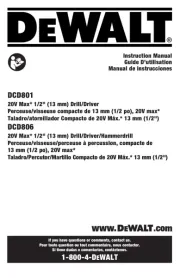
3 Augustus 2025
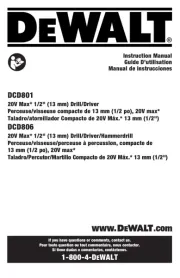
29 Juli 2025

4 Juli 2025
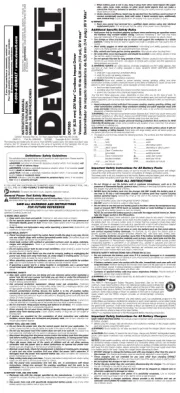
10 Juni 2025

2 Januari 2025

22 November 2024

15 November 2024

2 November 2024

23 September 2024

11 September 2024
Handleiding Boormachine
- Genesis
- Total
- Blucave
- Tryton
- Kraftixx
- Porter-Cable
- Toolson
- King Craft
- Fieldmann
- Dexter
- Rodcraft
- Maestro
- Meec Tools
- Profitech
- Mac Tools
Nieuwste handleidingen voor Boormachine
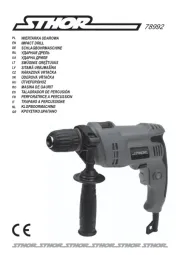
13 September 2025
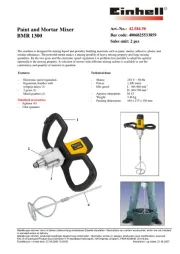
13 September 2025
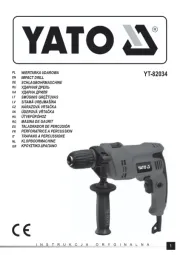
12 September 2025
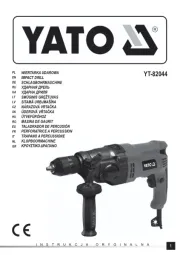
12 September 2025
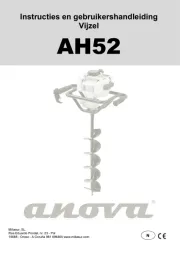
9 September 2025
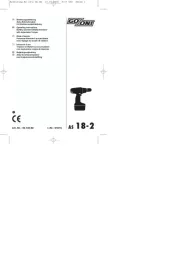
8 September 2025
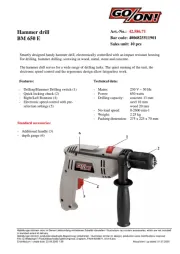
7 September 2025
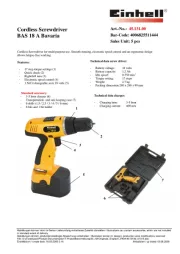
2 September 2025
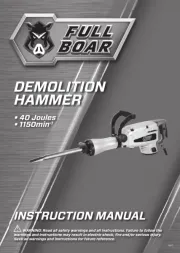
2 September 2025
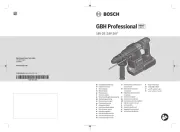
2 September 2025